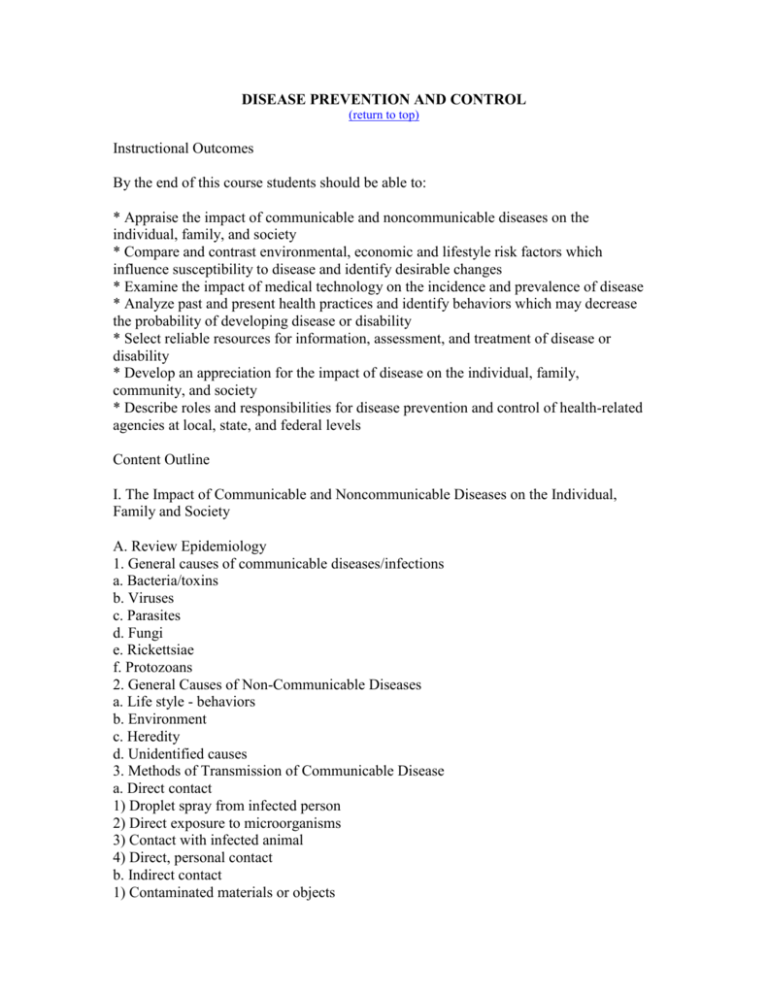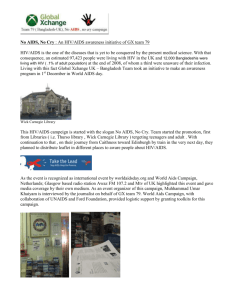DISEASE PREVENTION AND CONTROL
advertisement

DISEASE PREVENTION AND CONTROL (return to top) Instructional Outcomes By the end of this course students should be able to: * Appraise the impact of communicable and noncommunicable diseases on the individual, family, and society * Compare and contrast environmental, economic and lifestyle risk factors which influence susceptibility to disease and identify desirable changes * Examine the impact of medical technology on the incidence and prevalence of disease * Analyze past and present health practices and identify behaviors which may decrease the probability of developing disease or disability * Select reliable resources for information, assessment, and treatment of disease or disability * Develop an appreciation for the impact of disease on the individual, family, community, and society * Describe roles and responsibilities for disease prevention and control of health-related agencies at local, state, and federal levels Content Outline I. The Impact of Communicable and Noncommunicable Diseases on the Individual, Family and Society A. Review Epidemiology 1. General causes of communicable diseases/infections a. Bacteria/toxins b. Viruses c. Parasites d. Fungi e. Rickettsiae f. Protozoans 2. General Causes of Non-Communicable Diseases a. Life style - behaviors b. Environment c. Heredity d. Unidentified causes 3. Methods of Transmission of Communicable Disease a. Direct contact 1) Droplet spray from infected person 2) Direct exposure to microorganisms 3) Contact with infected animal 4) Direct, personal contact b. Indirect contact 1) Contaminated materials or objects 2) Contaminated food, water, milk 3) Contaminated biological products 4) Vectors - something that carries disease a) Deer ticks - Lyme Disease b) Rats - Bubonic Plague 4. Methods of Developing Resistance to Disease or Infection a. Natural immunity 1) Active - previous exposure to pathogen 2) Passive - passed from mother to baby b. Acquired immunity 1) Active - immunization with "live" vaccine 2) Passive - general immunization - short term 5. Risk Factors For Disease a. Inadequate personal hygiene b. Inadequate nutrition/diet c. Lack of physical fitness d. Exposure to pathogens e. Unsafe sexual practices B. Expanded Understanding of Chronic Diseases and Disabling Conditions 1. Differentiate Between Controllable and Uncontrollable Risk Factors a. Controllable 1) Personal hygiene 2) Lack of medical/dental/vision care (i.e., regular check-up) 3) Diet 4) Fitness 5) Smoking 6) Alcohol abuse 7) Drug abuse 8) Risky sexual behaviors b. Uncontrollable Risks 1) Gender 2) Age 3) Heredity 4) Environment 2. Specific Diseases and Their Impact On the Individual, Family, and Society (briefly review specific diseases, signs and symptoms, method of transmission, prevention, and treatment) a. Cardiovascular diseases 1) Atherosclerosis 2) Arteriosclerosis 3) Stroke b. Cancers 1) Skin 2) Lung 3) Breast 4) Colo-rectal 5) Prostate 6) Testicular c. Sexually transmitted diseases 1) HIV/AIDS 2) Gonorrhea 3) Chlamydia d. Other diseases 1) Common childhood illnesses 2) Asthma 3) Diabetes 4) Contemporary illnesses or outbreaks a) Lyme disease b) Hunta Virus c) Ebola II. Promoting a Healthy Lifestyle and Reducing Risk of Disease A. Lifestyle Factors (emphasize the value of building the body's natural defenses against disease by a lifestyle devoted to wellness) 1. Healthful Lifestyles and Optimal Well-Being and Their Value in Reducing the Risk of Disease a. The value of living a healthful lifestyle b. The components of wellness 1) Emotional: feelings; how one reacts to events 2) Physical: exercise, diet, rest 3) Intellectual: ability to learn and utilize knowledge 4) Social: interaction with others 5) Spiritual: need for meaning and purpose in life c. Formulation of a personal plan for wellness 1) Review of individual health habits related to risk of developing disease 2) Interview of family to determine genetic risks 3) Evaluation of eating, sleeping, exercise patterns 4) Ways to avoid risky behaviors and situations 5) Practice using resistance skills B. Impact of Medical Technology on the Incidence and Prevalence of Disease 1. Methods of detection and treatment a. Self-examination b. Genetic evaluation c. Screening tests (i.e., MRI, Cat Scans) d. Radiation e. Dietary changes f. Physical therapy g. Psychotherapy h. Surgery/Transplants i. Chemotherapy j. Biotechnology k. Medication C. Advantages and Disadvantages of Treatment Choices 1. Accessibility 2. Cost 3. Availability 4. Experimental procedures III. Roles and Responsibilities of Health-Related Agencies at Local, State, and Federal Levels A. Analyze Responsibilities of Public and Private Health-Related Agencies 1. Impact of community and environmental factors on total health and living standards 2. Major laws dealing with disease control and disability a. Americans with Disabilities Act b. Immunization of school-aged children c. Others 3. Career opportunities in health-related agencies B. Resources for Information, Assessment, and Treatment of Disease or Disability 1. U. S. Department of Health and Human Services 2. Centers for Disease Control and Prevention 3. National Institutes of Health 4. Health Education Resource Organization (HERO) 5. Health/wellness letters 6. Information services 7. School personnel who can be helpful in accessing community services a. nurse b. counselor c. teacher d. administrator 8. Others C. Resources For Information, Assessment, Equipment, and/or Treatment of Disease or Disability 1. Protective Services 2. Sexual Assault Center 3. Crisis Center 4. Health Department 5. American Cancer Society 6. Whitman-Walker Clinic 7. Planned Parenthood 8. Christine Foundation 9. Lions Club 10. Easter Seal Foundation 11. Hospice 12. Shriners 13. American Heart Association 14. American Lung Association 15. Others Content Resources: Discover Decisions for Health, Educational Assessment Publishing Co., 1993. Disease Prevention, Health Facts Series, ETR Associates, 1994. Glencoe Health, MacMillan/McGraw-Hill, 1994. HIV Prevention, Health Facts Series, ETR Associates, 1994. Perspectives on Health, D. C. Heath and Company, 1994. STD Prevention, Health Facts Series, ETR Associates, 1994. Straight Talk (student booklet - Obtain from physical education resource teacher) Understanding HIV Infection and AIDS (student booklet - obtain from physical education resource teacher) AIDS and Society, Glencoe Health, MacMillan/McGraw-Hill, 1994. Activity Resources: Comprehensive School Health Education, Second Edition, Meeks Heit Publishing Co., 1996. Education for Sexuality and HIV/AIDS, Meeks Heit Publishing Co., 1993. Reducing the Risk-Building Skills to Prevent Pregnancy, STD, and HIV, ETR Associates, 1993. STD and HIV, Choosing Health Series, ETR Associates, 1997. Videos: "BSE For Teens," available from American Cancer Society "STDs: More Bugs, More Problems," V3791 "It Won't Happen to Me," (AIDS) in each high school media center "AIDS: What Everyone Needs to Know," V2219 "AIDS Movie," V2044 "No Second Chance," (AIDS) V4004 "Sexually Transmitted Diseases: What You Should Know," V2695 "Testicular Self-Examination," V1677 "A Special Touch," (breast self-examination), V5121 "AIDS: A Decision for Life," V4868 "Face To Face With AIDS," V2839 "Don't Get It: Teenagers and AIDS," V2793 "AIDS: Suddenly Sex Has Become Very Dangerous," V2697 "Just Like Us: AIDS Prevention," V5689 "Suntan Now, Skin Cancer Later," V5477 "AIDS: What Everyone Needs To Know - 3rd Edition," V2219 "HIV and Teens: Remembering Krista Blake," V6163 "Preventing A Heart Attack," 19 min., V5737 "Infectious Disease," V6382 "Hepatitis," V6385 "Heart Disease," V6380 "Cancer," V6378 Guest Speakers: National Kidney Foundation (202) 244-7900 American Lung Association (301) 483-3164







